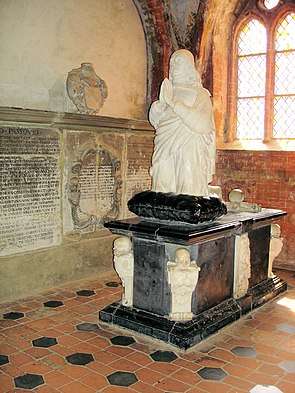Charles Philippe Dieussart
Charles Philippe Dieussart (also Charles Philipp) (ca. 1625-1696) was a Dutch architect and sculptor, active in Germany in the second half of the seventeenth century. Most notably, he designed the Jagdschloss Glienicke, today a UNESCO World Heritage Site.
Life
Dieussart was descended from French Huguenots who had moved to the Dutch Republic and is thought to have been born in Rome.[lower-alpha 1] His brother was the sculptor Jean Baptiste Dieussart, who mainly worked in Sweden.[1][2] In 1657 he entered the service of Duke Gustav Adolf of Mecklenburg-Güstrow. His first important commission, which remained among his most important contributions, was the Rossewitz Castle, the first Baroque building in Mecklenburg. Also well-known is the tomb he designed for Günther von Passow in the Güstrow Cathedral.
He wrote the book Theatrum architecturae civilis [3][4] that was published in several editions (1679 and 1682 in Güstrow, 1692 and possibly also 1695 in Bayreuth),[3] dedicated to various of his patrons,[lower-alpha 2][3] and for which the architect Leonhard Dientzenhofer commissioned a posthumous edition in Bamberg (with changed dedication and foreword)[5] in 1697.[6]
Notes
- In his book, Dieussart identifies himself as the author as "Carlo Philippo Deussart. Rom.", which may indicate that he was originally from Rome. He is also believed to be a son of the sculptor François Dieussart [1] who was working in Rome between 1622 and 1636.
- Digitized editions:
- 1679 edition, dedicated to Duke Gustav Adolf of Mecklenburg-Güstrow: Theatrum architecturae civilis (in German), Güstrow: Christian Scheippel, 1679
- 1679 edition, dedicated to Duke Christian Ludwig of Mecklenburg: Theatrum architecturae civilis (in German), Güstrow: Christian Scheippel, 1679
- 1679 edition, dedicated to Duke of Prussia and Elector of Brandenburg Frederick William: Theatrum architecturae civilis (in German), Güstrow: Christian Scheippel, 1679
- 1682 edition, dedicated to Duke of Prussia and Elector of Brandenburg Frederick William: Theatrum architecturae civilis (in German), Güstrow: Johann Spierling, 1682
- 1692 edition, dedicated to Christian Ernst, Margrave of Brandenburg-Bayreuth: Theatrum architecturae civilis (in German), Bayreuth: Johann Georg Amelung, 1692
References
- Bertil Waldén (1945), "Jean Baptista Dieussart", Svenskt biografiskt lexikon (in Swedish), retrieved 2019-03-09
- Bertil Waldén (1942), Nicolaes Millich och hans krets: studier i den karolinska barockens bildhuggarkonst (in Swedish), Stockholm: Saxon & Lindströms förlagCS1 maint: multiple names: authors list (link)
- Ulrich Thieme, ed. (1913), "Dieussart, Charles Philippe", Allgemeines Lexikon der bildenden Künstler von der Antike bis zur Gegenwart (in German), 9, Leipzig: E. A. Seemann
- Ulrich Schütte, "Als wenn eine ganze Ordnung da stünde...": Anmerkungen zum System der Säulenordnungen und seiner Auflösung im späten 18. Jahrhundert, Zeitschrift für Kunstgeschichte, 44 Bd., H. 1. (1981), pp. 15-37
- Charles Philippe Dieussart (1697), Theatrum architecturae civilis (in German), reissued by Leonhard Dientzenhofer, Bamberg: Johann Jacob Immel
- Ulrich Thieme, ed. (1913), "Dientzenhofer, Johann Leonhard", Allgemeines Lexikon der bildenden Künstler von der Antike bis zur Gegenwart (in German), 9, Leipzig: E. A. Seemann
| Wikimedia Commons has media related to Charles Philippe Dieussart. |
